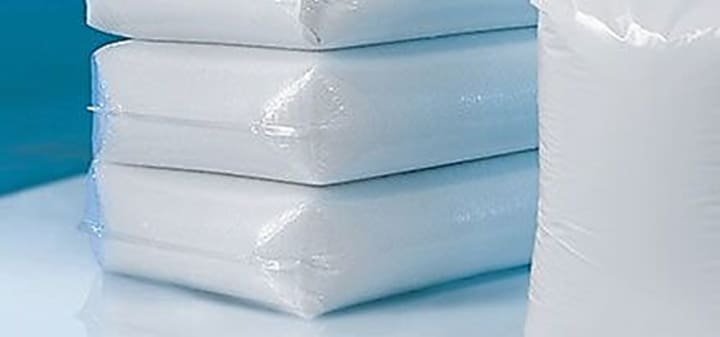How to produce heavy-duty bags?
Heavy-duty bags and a practical structure

By: Matthew Tabassi
Heavy-duty bags are the plastic bags used to hold and ship items such as lawn and garden fertilizer, potting soil, pet litter, water softening salts, rock salt, industrial chemicals, insulating wool, peat moss, top soil etc. The bags usually differ in the quantity or weight of the packed product, typically are 10 to 30 kg.
This type of bags provides some barrier against water and moisture, suitable for jobs short-term outdoor storage, provides better sealing, provides the potential for product visibility and excellent graphics and guarantees greater ease of opening.
Usually produced on a 3 or 5 layers co-extrusion line, and fractional melt LDPE is the dominant resin used for the production of heavy-duty bags. Heavy-duty bags are also made with blends of LDPE and LLDPE (25-40% for LDPE and 60-75% for LLDPE). LLDPE has significantly reduced the final thickness. LDPE is used to reduce the tendency of the film to slip and to improve processability. HDPE is used for stiffness and increased end use temperature resistance. EVA polymers are used for low temperature and better weldability in fill-fill-joint applications.
In the past, heavy-duty bags were made with thick monolayer (200 μm) films, multilayer structures (paper / sheet / HDPE) or multi-walled paper bags. The current trend is towards coextrusion, which allows a significant reduction in costs, thanks to the possibility of reducing the gauge (typical thickness 100-120 μm). Co-extrusion allows the use of several different colored layers to protect the contents of the bag (e.g. black inner layers, white outer layers) a layer of tacky skin layer to prevent "creep" or slipping when bags are stacked on pallet, the ability to retain stiff while providing a good sealing among the other advantages.
Robust structure of heavy-duty bags differs them from conventional bags in volume or weight of the products packed in them. They are normally designed to support weights more than 12 kg or for bulky items with a lower weight. Heavy-duty bags can be manufactured from polyethylene or polypropylene film, woven polypropylene, paper (normally multi-wall) or a combination of the above. This paper examines bags made from blown film equipment for polyethylene and / or polypropylene films.
Typical products packed in heavy duty sacks include:
· Bird Seed · Fertilizer · Sand · Carbon Black · Insulation Materials · Tree Bark · Chemicals · Peat Moss ·Water Treatments · De-icing Salt · Pet Food · Wood Pellets · Explosives · Pet Litter · Wood Shavings · Garden Compost · Plastic Resins · Hazardous · Garden Mulch · Potting Soil · Waste
Products packaged in heavy-duty plastic bags are more attractive to consumers by providing greater clarity where needed, higher strength, weather resistance, water resistance and ability to offer better gloss and better printability. The use of coextruded film structures provides the ability to better tailor the packaging to the requirement of the market. Examples of specialized co-extruded bags are those with a black interior to protect the contents, but the color white or similar to facilitate the impression / attractiveness of the consumer, another example is the use of a tacky skin surface for bags to prevent movement of cargo during transport.
Some of the critical properties required for a heavy bag are: high tensile strength, high puncture resistance, high sealing strength, low sliding of the outer surface and high stability during filling with hot material.

In the vast majority of cases, the heavy-duty bags are made directly from the blown film tube, therefore, the width of these lines is relatively small, typically a range of layflat widths of 400 to 800mm.
Therefore, being able to hold some form of biaxial orientation to maximize the construction of the body of the bag properties, small diameter dies are used to provide an appropriate inflation ratio. Usually dies for heavy-duty bags are with a diameter of 150 to 200 mm. Using a conventional die design, with the small diameter of the die often limits the ability to use large volumes of cooling air with an IBC system, which in turn can limit total output.
However, using the maximum IBC air flow on a specially designed die head, it is possible to obtain output rates above 260 kg / h with a die with a diameter of 180 mm. Using a larger die diameter will decrease the BUR and that will reduce the throughput rate with the larger die, therefore we see no advantage in the yield, but still have unfavorable effect on physical properties.
The preferred gauge band randomization employed is to use a stationary die and an oscillating nip, especially for co-extruded dies. However, care must be taken with the collapsing frame assembly and primary nip to avoid creasing the edges of the flattened tube whilst the film is still hot otherwise it may cause poor seam strength and cause the bag to break during filling and dosing.

To optimize the automated filling process, both the film thickness tolerance and the layflat width the tolerance should be very tight to ensure the bag can be opened, filled and sealed at high speed in a reliable method. Therefore, it is not uncommon to employ some form of automatic gauge control and accurate layflat width control. The flat width adjustment is usually performed using a sizing cage.
Most heavy-duty bag lines use a single, simple surface wrapper that can wrap the rolls more than a meter in diameter.
There is a trend among many major manufacturers producers to treat, print, and post gusset where necessary in-line with the film extrusion. The printed film can then be rolled up for subsequent bag manufacture, or more normally fed directly into a bag making machine.
Product specifications:
Width: 390mm + 2X80mm Gussets
Thickness: 160 microns
Color: Clear
Output: 155 kg/hr
BUR: 1.95:1
Structure: 30%/40%/30 - Inside layer (A/B/C) outside layer
Melt temp: 196-202 °C
Air ring: Dual Lips
Cooling air: 10°C
Starting guide Formula:
Ext. A: 48% (518N) + 48% (TX7003) + 1.5% (SAS) + 2.5% (AMF 702)
Ext. B: 46.5% (518N) + 46.5% (TX7003) + 5.5% (L425) + 1.5% (SAS)
Ext. C: 48% (518N) + 48% (TX7003) + 1.5% (SAS) + 2.5% (AMF 702)
Resin grades:
SABIC® LLDPE 518N is a butene LLDPE resin. Melt flow is 0.500 g/10 min.
Braskem TX7003 LDPE resin. Melt flow is 0.27 g/10 min.
Bayport Polymers Baystar™ L425 HDPE resin. Melt flow is 0.400 g/10 min.
POLYBATCH® AMF 702 by A. Schulman is a processing aid.
POLYBATCH® SAS by A. Schulman is an anti-slip masterbatch
Note: if you need to develop a special type of heavy-duty film for bags (sacks), I can help you for development. I can provide you cost saving formulation with available resins in your country / region.






Comments
There are no comments for this story
Be the first to respond and start the conversation.